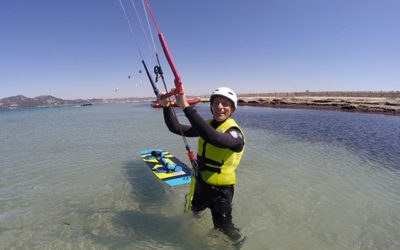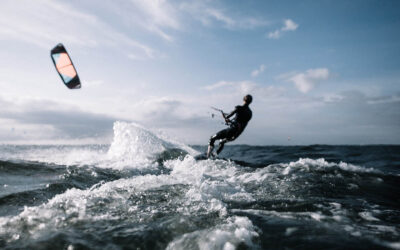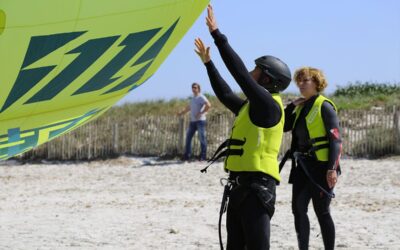Some tips for the maintenance of your kitesurf equipment
Here we go! You’ve taken lessons (with us maybe?), you’ve progressed to the point of renting in full autonomy, and now you’ve acquired your equipment, your kite, your board, your wetsuit!
It’s a real investment, but it’s also a good attitude to adopt to take care of your equipment for your safety. Checking your sail, the ropes, checking the board, it should never be superfluous and useless to you. So before your sail ends up in a bag in the back of your garage, get into the right habits!
Maintenance and check points of the wing, spinnaker and seams
Rinsing your sail
If you are new to kitesurfing, you will have to face long and hard speeches about rinsing the sail! Because there are two schools of thought, and they both have their reasons. To rinse with clear water, or not?
We won’t go through all the arguments again, because the comments will multiply. Rinsing your sail with fresh city water is not a good idea, because this water contains products that do not do any good to the fabric or the seams. Not rinsing the sail and letting the salt settle protects against mildew, but gradually damages the fabric and seams.
The best thing to do is to take the time to let it dry in the wind, and to lie on the sand and watch the sea while it dries. And you can rinse it once in 10 times to remove the salt crystals that have accumulated, and take the opportunity to do a thorough check.
There are special shampoos for your wing. And don’t forget a soft brush to get the salt out of all the gaps and seams.
Take the time to fold it well, or fold it in a clean and dry place if you don’t plan to do a session soon!
As for inflation, we advise you to take 20 minutes between inflation and your launch, just to be sure that the pressure is stable, but we obviously count on your common sense to have thought about it before!
Check the seams
Your wing is a patchwork of fabric panels. They are glued together, but this gluing is reinforced by seams, which cause holes in the sail.
You should therefore check the thread, which is basically very strong, but also the size of the holes, a parameter that will tell you how worn the sail is. Holes that are too visible are a sign that the spinnaker is getting old and should be taken seriously. So take advantage of a nice sunny day, whether on the beach or in your garden, inflate your wing and put it against the light. And look at all the seams. If some of them need to be reworked, take a felt-tip pen or some labels, the sailmaker who will repair your spinnaker will be grateful!
The helm and the lines: maintenance and adjustments
Lines get tangled, knotted and frayed. You will take time to check them for wear and tear, but also for calibration, i.e. that they are all the same length. It’s not a long process, and it’s essential for better and safer sailing.
Find a fixed point, tie your lines, all 4 of them together, and pinch each line and thread it through your fingers. Every knot, every frayed section should be inspected. Change a line that is too damaged, never hesitate, and never wait too long.
Take your bar, attach the back and front lines, and check the calibration. There are tutorials for setting up the whole thing, and we will always be at your service to give you good advice!
The board and the wetsuit: don’t neglect them!
Rinsing the board and wetsuit is essential after each session. Don’t neglect rinsing your wetsuit and drying it (not in the tumble dryer!) in the open air until it is completely dry! It will remain supple, waterproof and soft to put on.
As for the board, rinse it and store it in its bag, and don’t forget that it is neither unbreakable nor eternal.
Whether in our offices or on the DUOTONE or ION websites, good advice will always be offered to you with pleasure so that you can continue to ride safely!
Search
Catégories
Recent Posts
Suivez-nous !












